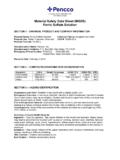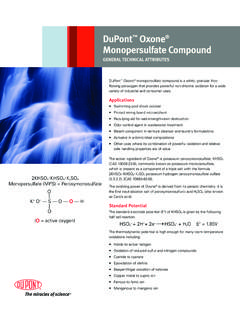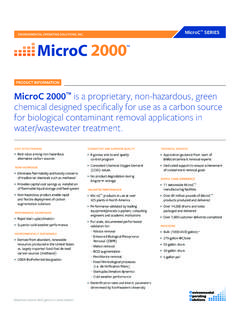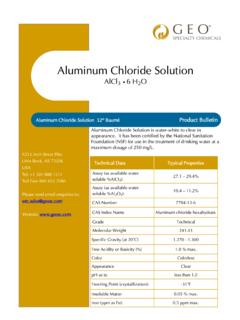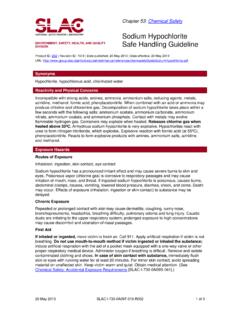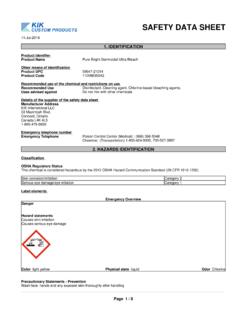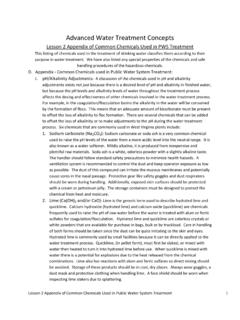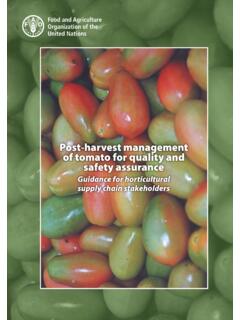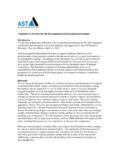Transcription of TECHNICAL BULLETIN ~ SODIUM HYPOCHLORITE
1 WATER GUARD, INC 1903 HERRING AVENUE (800) 872-7665 POST OFFICE BOX 2226 (252) 237-5205 WILSON, NC 27894 FAX: (252) 237-7028 TECHNICAL BULLETIN ~ SODIUM HYPOCHLORITE SODIUM HYPOCHLORITE SOLUTION is a greenish-yellow liquid weighing approximately 10 lbs. per gallon with a specific gravity of This product is commonly known as INDUSTRIAL BLEACH to dis-tinguish it from the more common household bleach. The difference is the strength of the available chlo-rine. Household bleach has available chlorine while Industrial Bleach has available chorine of The trade percentage of Industrial Beach is 15% available chlorine.
2 The difference in percent-age is because there is 15% available chlorine by volume and available chlorine by weight. SODIUM HYPOCHLORITE replaces many other forms of chlorine because of the ease of use and relatively safe handling and storage requirements. There is a trend by many municipalities to convert gas chlorine systems to liquid systems because of the hazards associated with gas chlorine use. SODIUM Hypochlo-rite is fed into a system with a relatively inexpensive chemical feed pump. It requires no mixing and can be used directly from the shipping container or a bulk storage tank.
3 REGISTRATIONS Environmental Protection Agency: Classified as a pesticide when used for disinfection. Subject to provisions of the Federal Insecticide, Fungicide, and Rodenticide Act. EPA Registration Number: 49927-04 Department of Agriculture: Approved for food plant use where chemical may come in contact with food & food preparation areas. National Sanitation Foundation: Water Guard s SODIUM HYPOCHLORITE is NSF/ANSI 60 approved for use in drinking water systems for dis-infection and oxidation purposes. The maximum use limit must not exceed 84mg/L. State Registrations: Registered for sale in the states of North Carolina, Virginia, and South Carolina.
4 STORAGE & handling The most important detriment of SODIUM HYPOCHLORITE is the limited shelf life of the material. All SODIUM HYPOCHLORITE Solutions will decompose. The major factors affecting stability are the solution s pH, its concentration, temperature, exposure to light and exposure to organic and metallic impurities. With all these variable elements affecting the shelf life of the products, Water Guard wants to insure the purest and most stable SODIUM HYPOCHLORITE available to its Customers. We recommend purchasing no more SODIUM HYPOCHLORITE than can be consumed in 5 weeks or less.
5 The product should be stored in clean containers, in coolest available environment out of direct sunlight. Proper planning and knowledge of the chemical properties can ensure maximizing the advantages of SODIUM HYPOCHLORITE Solution. Anyone handling the material should always wear appropriate safety gear and should read and under-stand the Material Safety Data Sheet for the product. Never should this product be mixed directly with any other chemical. For further questions regarding the storage and handling of SODIUM HYPOCHLORITE , contact a Water Guard customer representative. WATER GUARD, INC 1903 HERRING AVENUE (800) 872-7665 POST OFFICE BOX 2226 (252) 237-5205 WILSON, NC 27894 FAX: (252) 237-7028 TECHNICAL BULLETIN ~ SODIUM HYPOCHLORITE CALCULATION FOR USE The amount of SODIUM HYPOCHLORITE (Industrial Bleach) needed is based on the amount of chlorine de-sired in the system to be treated.
6 There is lbs. of pure chlorine in a gallon of Industrial Bleach. One gallon of Industrial Bleach is 120,000 gallons of water will yield approximately parts per million (ppm) of chlorine. The following formulas are used to calculate the amount of chlorine in water: Pounds of pure chlorine = (ppm) x (million gallons system water) x ( ) For Example: If you want 5 ppm of chlorine in 500,000 gallons of water you need to add pounds of pure chlorine. (5) x (.5) x ( ) = Note: To calculate the amount of water in million gallons, move the decimal point 6 places to the left.
7 500,000 is million gallons after moving the decimal point 6 places to the left. 500 gallons is million gallons. Relating this calculation to SODIUM HYPOCHLORITE , you will need gallons of SODIUM HYPOCHLORITE to yield pounds of pure chlorine. lbs. of pure chlorine pure chlorine / gallon = gallons Using this same basic formula you can determine what the ppm will be from the addition of a certain amount of chlorine in a system: ppm = (lbs. of pure chlorine) (million gallons of water) x ( ) For Example: If 12 pounds of pure chlorine is added to 750,000 gallons of system water there will be ppm of chlorine in the water system.
8 (12) x ( ) x ( ) = Note: In terms of SODIUM HYPOCHLORITE , gallons of Industrial Bleach will yield 12 pounds of pure chlo-rine. (12 by ) WATER GUARD, INC 1903 HERRING AVENUE (800) 872-7665 POST OFFICE BOX 2226 (252) 237-5205 WILSON, NC 27894 FAX: (252) 237-7028 TECHNICAL BULLETIN ~ SODIUM HYPOCHLORITE DECOMPOSITION OF SODIUM HYPOCHLORITE SODIUM HYPOCHLORITE is unstable and has a limited shelf life. The chemical will decompose and the avail-able chlorine will decrease over time. Several factors affect the rate of decomposition. The major factors affecting stability are the solution s pH, its concentration, temperature, exposure to light and exposure to organic and metallic impurities.
9 Water Guard s SODIUM HYPOCHLORITE is made with the minimum of impurities. Our product is the most stable material available but care should be taken to reduce the possibility of decomposition during stor-age at your facility. We recommend that you do not purchase any more product than you can consume in five weeks or less. Even under ideal conditions, the amount of available chlorine will decrease over time. The Chlorine In-stitute has developed a formula for estimating the concentration of material stored at 80 F with an origi-nal available chlorine concentration of 13%: THE EFFECT OF DECOMPOSITION ON THE COST OF CHLORINE As the available chlorine in the SODIUM HYPOCHLORITE decreases, the cost per pound of the available chlorine increases.
10 The following chart is the percentage increase in cost over time: As an example, if you purchase SODIUM HYPOCHLORITE for $ per gallon, the cost of the available chlo-rine is $ ( lbs. per gallon x = lbs. of chlorine. $ per lbs. = $ ) If the Bleach is stored for 45 days the percent decomposes to The cost of the available chlorine will increase to $ per pound. To get the same amount of Chlorine you originally had, you need gallons of this lower strength Bleach. In effect, the cost of the Bleach will have increased from $ per gallon to $ per gallon based on the increased gallons needed for the same amount of Chlorine.

